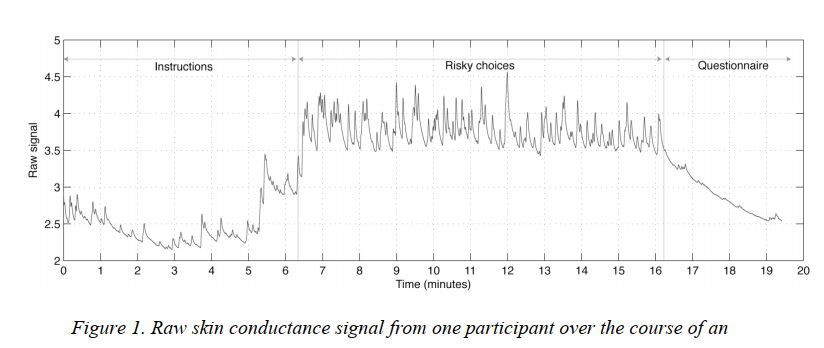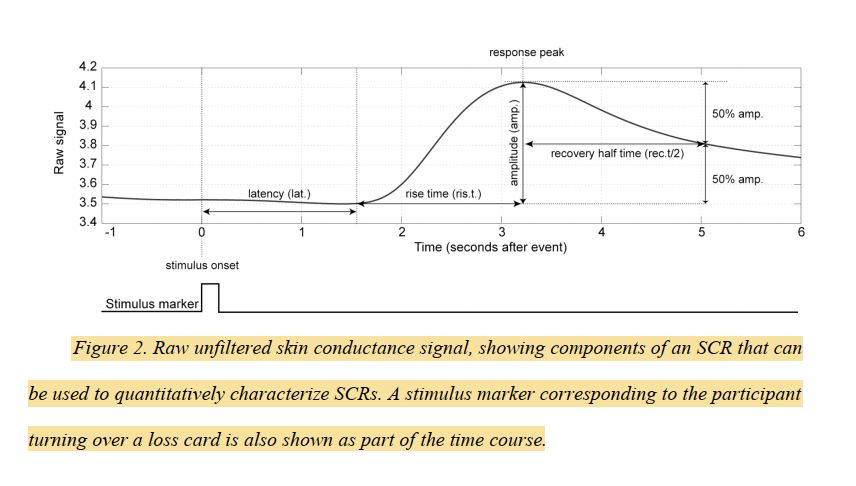Electrodermal activity
Getting a pulse on our lizard brain
Most of this information came from Figner and Murphy (2010).


- skin conductance (SC) indicates autonomic nervous system (ANS) activity
- the ANS does a lot, so SC indicates a lot
- cheap, noninvasive, time domain of a few seconds
Interesting, the author cites an emotions revolution (Weber & Johnson, 2009) in neuroscience, which popularized a specific type of EDA: skin conductance.
- SC reflects hidden processes affecting decision-making
- SC is tricky, and there are some subtleties
Terminology
- electrodermal activity (EDA) measures electrical properties of the skin
- endosomatic = not using external current
- exosomatic = using external current (e.g. SC)
Measures of EDA quantify electrical properties of the skin
- skin conductance (SC) - DC - voltage held constant
- skin resistant - DC - current held constant
- skin admittance - AC - effective voltage held constant
- skin impedance - AC - effective current held constant
- SC measured in microsiemens ()
- skin conductance level (SCL) - the average trend of SC over minutes or 10s of minutes - indicates arousal
- skin conductance response (SCR) - SC peak and fall lasting a few seconds - responds to events - "phasic"
- tonic skin conductance (TSC?) - number of SCRs per minute
- onset latency - time from stimulus to SCR
- rise time - time between onset and max amplitude
- amplitude - SC at max minus SC at onset
- area bounded by curve of SCR - a more recent measure of the magnitude of an SCR
Process interpretation
-
SC changes are caused by sweating!
-
"sympathetic branch of ANS controls sweathing"
thus??"skin conductance reflects 'arousal' of the sympathetic ANS" -
ANS is in hypothalamus and brainstem, but other parts of limbic and paralimbic networks are involved
-
the "Iowa group"
- demonstrated SCL indicates affective processing before, during, and after making decisions
- showed that SCL indicates expected affect
-
Reid and Gonzalez-Vallejo (2009)
- showed that relative magnitude of SCRs is predictive of preferences
-
Krosch, Figner, & Weber
- used SCL to show something about "the CCT" (
???)
- used SCL to show something about "the CCT" (
Doing experiments
- equipment Biopac system, with SC and cardiovascular activity modules
- software (AcqKnowledge) that comes with it enables analysis
- author gives his whole set-up, down to each parameter - skip
- deep breaths give clear SCRs, and indicates the system is working
- because of SC's long latency, they used to long inter-stimulus periods, to let SC respond
- until rapid event-related designs -- allow SC responses to overlap, as in BOLD, deconvolving statistically
Other resources
- emotion etc... https://www.ncbi.nlm.nih.gov/pmc/articles/PMC2756702/
- amazing emotion sociology: thomas scheff, microsociology!!
- Analytic measures for quantification of arousal from spontaneous skin conductance fluctuations
- Interpersonal autonomic physiology